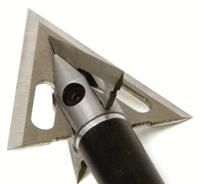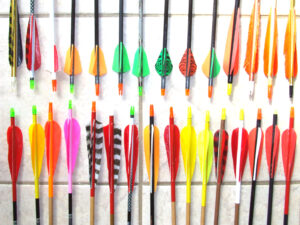What Are The Parts Of An Arrow?
An arrow will basically consist of four or five parts, or components. The names of the arrow parts may vary slightly from country to country, or region.

What are the parts of an arrow? The parts of an arrow consist of : 1. Nock, 2. Arrow shaft, 3. Insert, 4. Point and 5. Fletching.
Some arrows, like a wooden arrow do not use an insert, as the point might go over the shaft. So there is only four components.
Arrow parts and names.
The type and name of the components may also depend on what the arrow is designed for, like for bowhunting or target archery.
Arrow Shaft.
The shaft is the main long section of the arrow and the components are attach to it.
An arrow shaft might be made out of carbon fiber, aluminum, fiberglass or wood.
Some arrow shafts are made with a mixture of materials. Like a composite of carbon and aluminum.
Wooden arrows are still a popular material for traditional archers, like longbow shooters. The wooden shaft is generally heavy in weight.
For compound archers, the carbon arrow is one of the most popular choices.
Olympic recurve bow and compound target archers, generally prefer the lightweight carbon arrow shaft.
For indoor target arrows, the shaft choice might be carbon or aluminum. The weight of the arrow is not a concern for the close distance target. Also the arrows may hit each other, so some prefer the durable aluminum.
Before carbon, some older designed arrows were made out of fiberglass. This material is still preferred for bow fishing arrows, because of its heavy weight.
Types of arrow points.
 The point or tip can consist of all different designs. Depending on the purpose of the archer and their target.
The point or tip can consist of all different designs. Depending on the purpose of the archer and their target.
Some types of arrow points include; target points, field points, blunts and hunting broadheads.
Points can screw straight into the insert. Others are glued straight in a hollow shaft like a carbon arrow shaft. Or the point may be placed over a tapered wooden arrow.
Arrow points are made from everything from steel, plastic to rubber depending on style and design.
A small game arrow head like a judo point might be used. This stops the arrow from getting lost in the grass and penetrating too much on game.
Older primitive broadheads were made from flint, obsidian or bone.
Parts of an archery arrow, the insert.
An insert pushes inside the hollow shaft. This allows you to screw-in and change to a variety of tips, like, field points or broadheads.
Most inserts are made from aluminum. Some are steel or plastic and some are made of a brass mixture.
Not all arrows use an insert, like a wooden arrow.
An inset might also be used for the rear of the arrow, to insert an arrow nock.
Arrow fletching.

The fletching is located on the rear of the arrow and helps stabilize the arrow in flight.
The fletching might be glued on the shaft in a helical design. This helps spin the arrow and stabilize the arrow even more. Or it could put on straight or an off set design.
What are vanes? Fletching may also be called vanes if it is made out of plastic.
If the fletching is made out of feathers, it might be either called fletching or simply feathers. These might be made from turkey feathers or certain birds.
Generally the shaft will have three fletches. Sometimes four or even more are used for special type arrows or designs.
The fletching can consist of a wide variety of different colors. Different colors can help one archer identify their arrows from other archers.
There are some beautiful designs and combinations in both modern vanes and traditional turkey feathers.
One fletch or vane on the arrow, might be a different color to the other two. This one is called the cock-fletch. This helps identify which way to place the arrow on the string. Which helps with arrow clearance from the bow riser.
The other two color fletches are called the shaft fletching. (Often incorrectly called the hen-fletches.)
Arrow nock.
The nock is the part on the arrow where the string goes. The modern nock is made mostly out of hard plastic.
Depending on the arrow shaft material, the nock might be inserted into the shaft. Or placed over the tapered end of the arrow shaft.
Primitive arrow nocks were made from bone or wood. Some nocks were spliced in with a different harder wood into the shaft.
What are the different types of arrows?
A good arrow has been highly regarded for centuries. As it could be difference between winning and losing a battle.
There are several different types of arrows, depending on what style of archery you are doing.
Finding the right arrows that suits you is important to get the most out of your shooting and improve performance.
Hunting arrows.

Generally, hunting arrow shafts are heavier for penetration and are more robust.
Early hunting arrows were originally made of wood. Today arrows for hunting might be made from carbon fiber or aluminum materials.
Carbon arrows are popular for bowhunters using a compound bow.
The fletching for a hunting arrow may be longer to help guide the broadhead accurately.
Some vanes are short, but have a high profile so there is still a lot of surface area to help correct broadhead flight.
These high profile, but shorter vanes are ideal for shooting through arrow rests, like a whisker biscuit.
A Blazer vane is a good example of a high profile vane.
The fletching for a bowhunting arrow is normally put on the arrow shaft in a helical pattern. This helps spin the arrow for more guidance and accuracy through the air.
A wide broadhead may plane off course with straight, or minimal fletching on the shaft.
Bow fishing arrows.
For bow fishing, the arrows might be made out of fiberglass. Which is heavy and helps penetrate the water.
The fiberglass also won’t absorb water, as compared to a wooden shaft.
Flu-flu arrows.
For shooting aerial targets, or bowhunting for birds, a flu-flu arrow might be used.
The purpose of the flu-flu arrow is to limit the distance the arrow flies. So if an archer shooting at a high angle in the air, the arrow doesn’t go a long way and get lost.
The fletching of a flu-flu arrow is spiraled or wrapped around the shaft. The ultra large surface area of the fletching, causes a lot of drag and slows the arrow down.
Flu-flu arrows might be also used for hunting small game in trees.
Target arrows.

A target bow is generally lighter in the draw weight. (How much poundage, the archer is holding at full draw.) This is so the archer can hold the bow on the target longer for increased accuracy.
But because of the bows light draw weight and some targets are a long way away, the target arrow has to be lighter so it can reach the target.
Some of the targets are up to 90 meters away or 98.43 yards.
The point on a target arrow generally will glue straight into the shaft and doesn’t require an insert.
Most target points are one piece. Sometimes they are called a NIBB (New Improved Balance Bullet.) point.
The vanes or feathers will generally be a smaller lower profile on a target arrow. (As they don’t have to stabilize a large hunting broadhead.)
Side winds can also catch large vanes, or feathers on a windy day. So a smaller fletching might be used to minimize drag.
The fletching are generally put on with a slight offset to help spin the arrow. Or sometimes a very slight helical design is used for a target arrow. But generally not as extreme as a hunting arrow design.
Carbon arrows seem to be the most popular for target arrows. As the carbon’s light weight construction helps.
Aluminum arrows are still used by some target archers today. Indoor target archers may prefer the wide diameter profile and durable aluminum design.
For more information measuring an arrow correctly, click on, How To Measure An Arrow.
Parts of field arrows and 3D arrows.
The only part of the arrow that might differ from a target archery arrow is, you might use screw in field points.
This will depend on the individual archer and the different rules and regulations of the archery club or governing body.
Some 3D or field archery rules, require you use arrows of a similar weight or design of hunting arrows. (But no broadheads allowed.)
Flight arrows.
Flight archery is trying to shoot the arrow the maximum distance it can fly.
Special designed bows and arrows are used by archers, to try to get the longest distance. Some archers are continually improving their equipment and technique to bet the world record.
The flight arrows are tapered, balanced and have low drag fletching for more aerodynamic performance.
What is arrow spine?
Arrow spine is the amount of flex or bend the arrow moves. It is a measure of the arrows stiffness.
A lighter spine arrow, will bend a lot. A stiffer spine arrow is harder to flex.
The arrow spine should match the bows draw weight.
As an example, a heavy 70 lbs. hunting bow will require a properly spined arrow. Otherwise a soft spine arrow might bend too much and break.
The arrow spine is also important for accuracy.
Another example could be, a light poundage, 25 lbs. Olympic recurve bow, would not get the most out of using a very stiff heavy arrow. It would not flex enough for the bow and the arrow would veer of course.
Arrow spine selection is very important for tuning the bow. Arrow manufactures will have a chart to select the correct arrow for your draw weight and arrow length.
Types of arrow brands.
Some well-known brands of carbon arrows are Easton Archery, Gold Tip Arrows, Carbon Express and Victory Arrows. These manufactures use quality materials and have wide range of arrows to suit different poundage bows.
There are other reputable arrow brands as well, but these above brands have been around for a while and are popular.
Easton archery also manufactures aluminum arrows.
Arrow safety.
Check your local area for rules and regulations were you can shoot safely.
Have a large target to catch the arrow and make sure you shoot in a safe direction. Away from people, animals and objects in the background, in case you miss. Safety first.
Arrow safety. – Always inspect your arrow to make sure it is not damaged after each shot.
Avoid buying the no name, cheap arrows on eBay as the accuracy and durability is poor. Some of these arrows have no listed spine stiffness and have questionable safety concerns.
Shooting a low budget arrow out of a fast modern compound bow is dangerous.
Conclusion.
The parts of an arrow are; the shaft, fletching, nock and point.
Inserts are another component that might need to be used to fit some different points, depending on the arrow shaft.
If the fletching is made out of plastic, it can also be called vanes.
Assorted designs and materials, are used for different types of arrows and archery styles.
